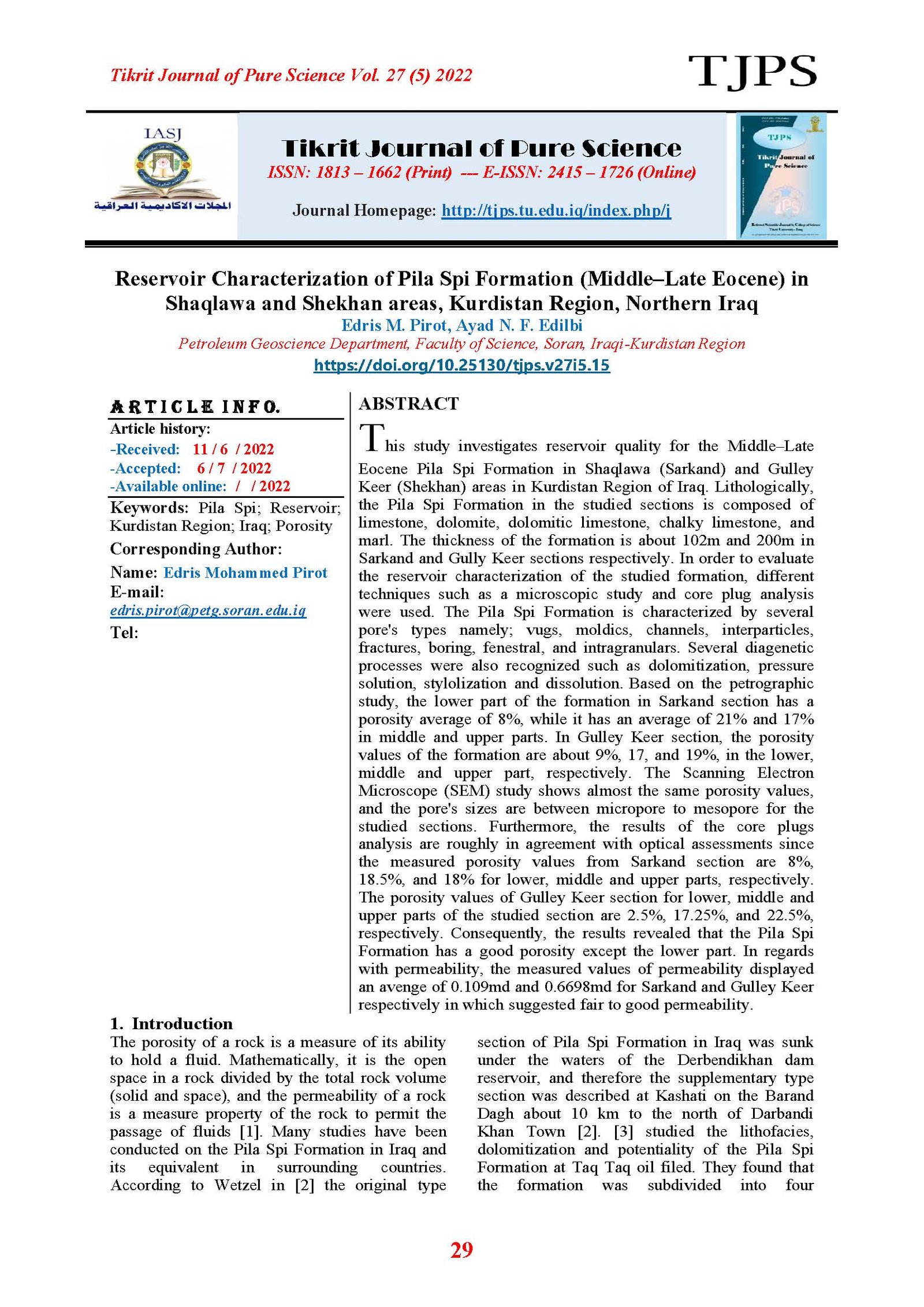Reservoir Characterization of Pila Spi Formation (Middle–Late Eocene) in Shaqlawa and Shekhan areas, Kurdistan Region, Northern Iraq
Main Article Content
Abstract
This study investigates reservoir quality for the Middle–Late Eocene Pila Spi Formation in Shaqlawa (Sarkand) and Gulley Keer (Shekhan) areas in Kurdistan Region of Iraq. Lithologically, the Pila Spi Formation in the studied sections is composed of limestone, dolomite, dolomitic limestone, chalky limestone, and marl. The thickness of the formation is about 102m and 200m in Sarkand and Gully Keer sections respectively. In order to evaluate the reservoir characterization of the studied formation, different techniques such as a microscopic study and core plug analysis were used. The Pila Spi Formation is characterized by several pore's types namely; vugs, moldics, channels, interparticles, fractures, boring, fenestral, and intragranulars. Several diagenetic processes were also recognized such as dolomitization, pressure solution, stylolization and dissolution. Based on the petrographic study, the lower part of the formation in Sarkand section has a porosity average of 8%, while it has an average of 21% and 17% in middle and upper parts. In Gulley Keer section, the porosity values of the formation are about 9%, 17, and 19%, in the lower, middle and upper part, respectively. The Scanning Electron Microscope (SEM) study shows almost the same porosity values, and the pore's sizes are between micropore to mesopore for the studied sections. Furthermore, the results of the core plugs analysis are roughly in agreement with optical assessments since the measured porosity values from Sarkand section are 8%, 18.5%, and 18% for lower, middle and upper parts, respectively. The porosity values of Gulley Keer section for lower, middle and upper parts of the studied section are 2.5%, 17.25%, and 22.5%, respectively. Consequently, the results revealed that the Pila Spi Formation has a good porosity except the lower part. In regards with permeability, the measured values of permeability displayed an avenge of 0.109md and 0.6698md for Sarkand and Gulley Keer respectively in which suggested fair to good permeability.
Article Details

This work is licensed under a Creative Commons Attribution 4.0 International License.
Tikrit Journal of Pure Science is licensed under the Creative Commons Attribution 4.0 International License, which allows users to copy, create extracts, abstracts, and new works from the article, alter and revise the article, and make commercial use of the article (including reuse and/or resale of the article by commercial entities), provided the user gives appropriate credit (with a link to the formal publication through the relevant DOI), provides a link to the license, indicates if changes were made, and the licensor is not represented as endorsing the use made of the work. The authors hold the copyright for their published work on the Tikrit J. Pure Sci. website, while Tikrit J. Pure Sci. is responsible for appreciate citation of their work, which is released under CC-BY-4.0, enabling the unrestricted use, distribution, and reproduction of an article in any medium, provided that the original work is properly cited.
References
[1] North, F.K. (1985). Petroleum Geology. Allen & Unwin, Boston: 607.
[2] Bellen, R.C., van, Dunnington, H.V., Wetzel, R., and Morton, D.M. (1959). Lexique Stratigraphique International, Asie, Fasc. 10a, Iraq, Paris: 333.
[3] Othman, D. and Al-Qayim, B. (2010). Lithofacies association, dolomitization, and potentiality of the Pila Spi Formation, Taq Taq oil field, Kurdistan region, NE Iraq. Iraqi Bulletin of Geology and Mining, GEOSURV, Baghdad, 6: 95-114.
[4] Dler H. Baban., and Kardo S. M. Ranyay. (2012). ‘Potentiality of Paleocene source rocks and their contribution in generating the accumulated oil in the Eocene Pila Spi Reservoir in Taq Taq Oil Field, Kurdistan Region, Iraq’, Saudi Society for Geosciences, 18 September.
[5] Al-Qaiym, B. A., and Othman, D. H. (2012). Reservoir characterization of an intra-orogenic Carbonates platform: Pila Spi Formation, Taq Taq oil
field, Kurdistan, Iraq, at University of Calgary, 6 (2): 139-168.
[6] Fouad, S.F. (2015). Tectonic map of Iraq, Tectonic Map of Iraq, Scale 1: 1000 000, 3rd Edition, 2012. Iraqi Bulletin of Geology and Mining, Vol.11, No.1, 2015: 1-7.
[7] Ditmar V Iraqi-Soviet Team. (1971). Geological conditions and hydrocarbon prospects of the Republic of Iraq (Northern and Central parts). Manuscript report, INOC Library, Baghdad.
[8] Jassim, S.Z., and Goff, J.C. (2006). Geology of Iraq. Dolin, Prague and Moravian Museum, Brno, Czech Republic: 341.
[9] Sissakian, V.K., Kadhim, T.H. & Abduljabbar, M.F. (2014). Geomorphology of the High Folded Zone. Iraqi Bulletin of Geology and Mining. Special Issue, (6): 7-51.
[10] Weber, F.H. (1963). Geology and mineral resources of San Diego County, California, California Division of Mines and Geology.
[11] Altinli, E. (1960). Geology of Eastern and
Southeastern Anatolia, Part I. M.T.A. Bull. Ankara, no. 66: 35-76.
[12] Ehrlich, R., Kennedy, S. K., Crabtree, S. J., and Cannon, R. L. (1984). Petrographic image analysis; Analysis of reservoir pore complexes, Journal of Sedimentary Petrology, 54: 136-1378.
[13] Anselmetti, F. S., Luthi, S., and Eberli, G. P. (1998). Quantitative characterization of carbonate pore systems by digital image analysis, AAPG Bulletin, 82: 1815-1836.
[14] Choquette, P.W., and Pray, L.C. (1970). Geologic nomenclature and classification of porosity in sedimentary carbonates. American Association of Petroleum Geologists, (54): 207-250.
[15] Larsen, G., and Chilingar, G.V. (1979). Diagenesis in Sediments and Sedimentary Rocks. Elsevier, New York: 319-320.
[16] Bathurst, R.G.C. (1975). Carbonate Sediment and Their Diagenesis. Development in Sedimentology, Elsevier, Amsterdam: 658.
[17] Blatt, H., Middleton, G., and Murray, R. (1980). Origin of Sedimentary Rocks. Englewood Cliffs, N.J.: PrenticeHall: 782.
[18] Levorsen, A.I. (1967). Geology of Petroleum. C.B.S Publishers and Distribution, Delhi: 77-137.
[19] Gluyas, J. and Swarbrick, R. (2004). Petroleum Geoscience. Blackwell Publishing, Hoboken: 359.
